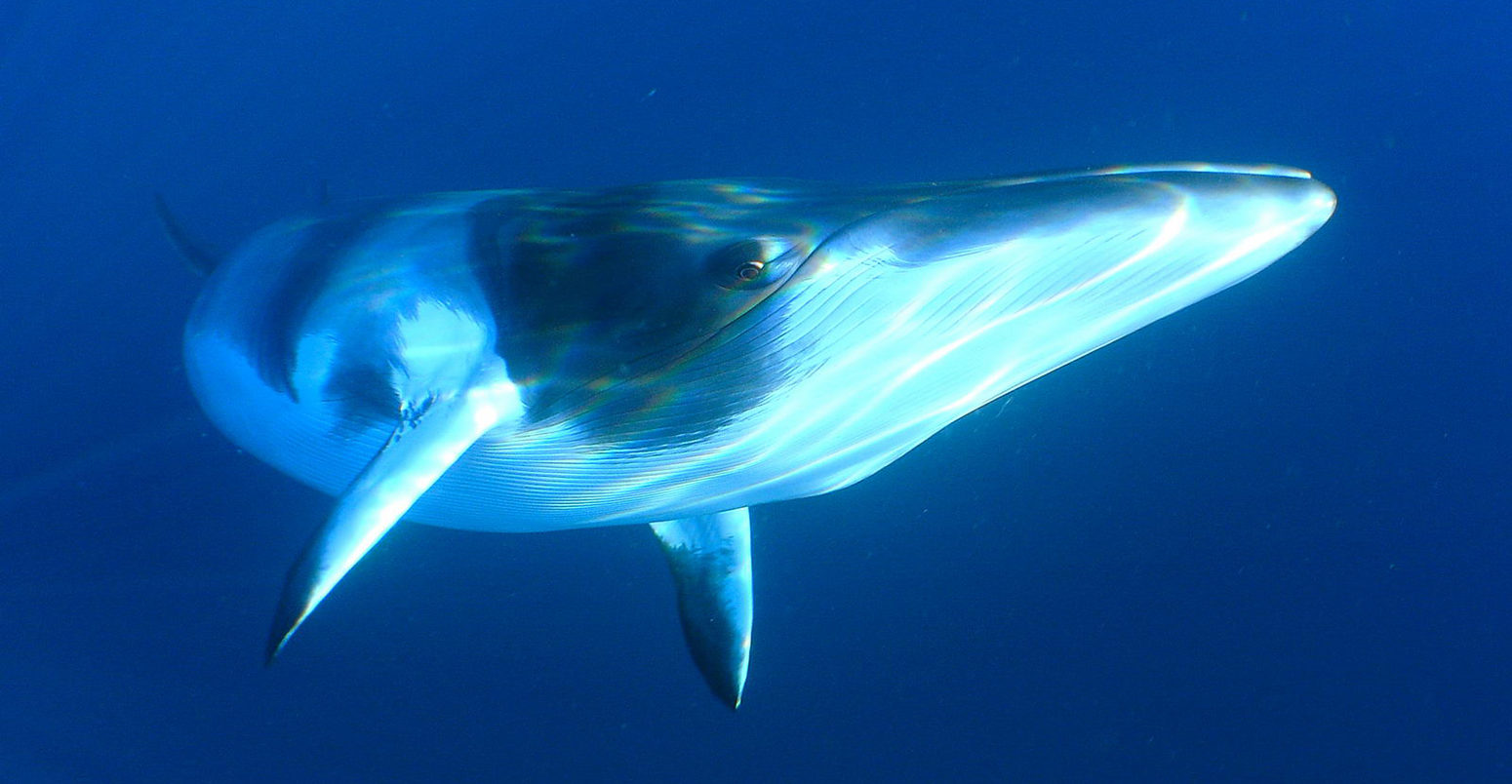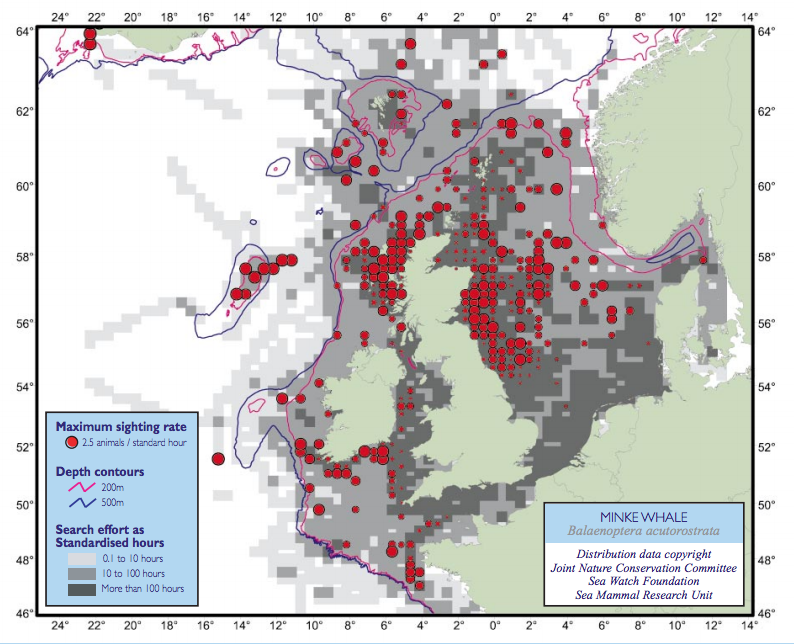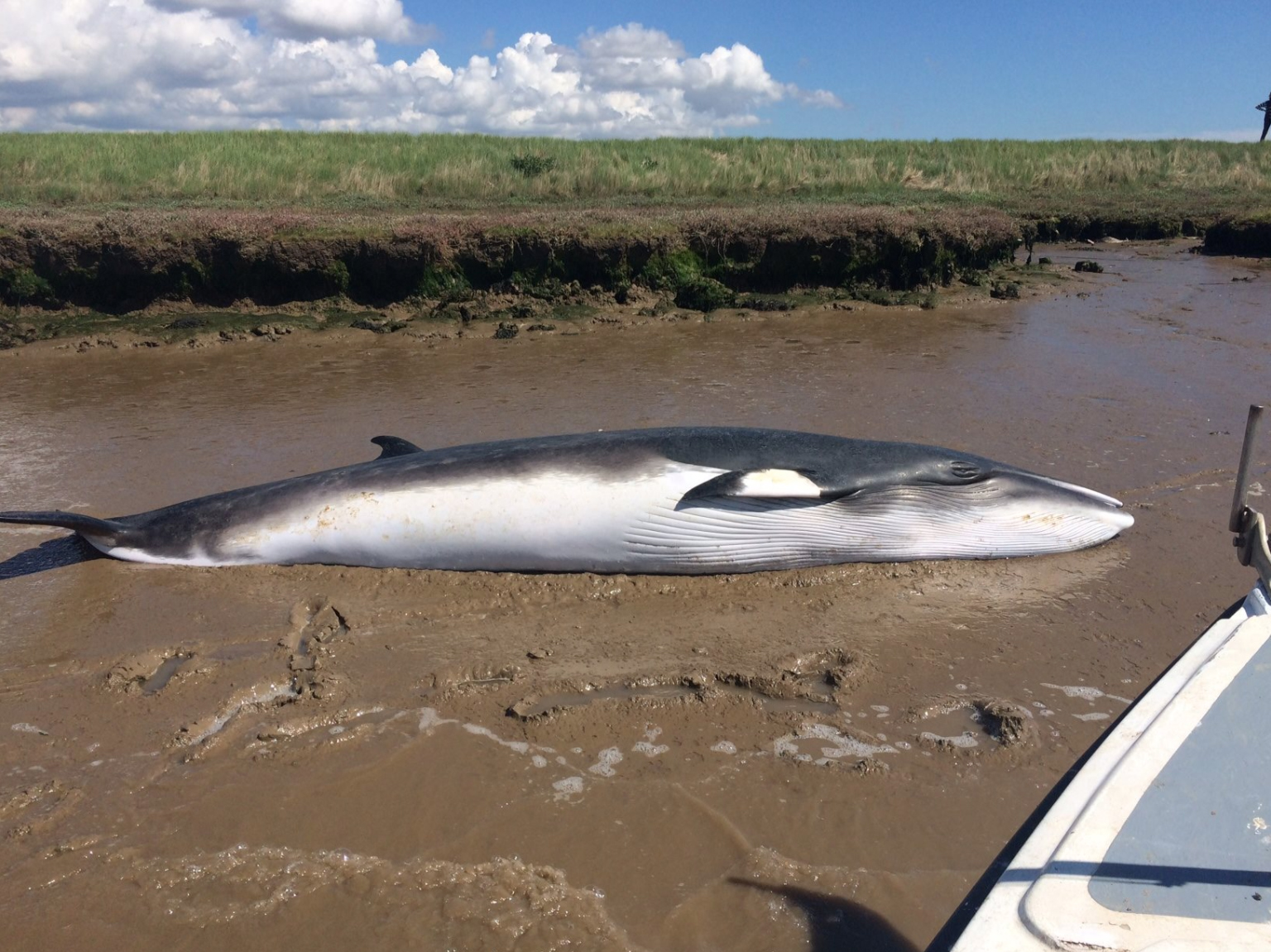
Factcheck: Whale strandings and offshore windfarms
Simon Evans
05.26.17Last Saturday, two dead whales washed up on the coast of Suffolk, in eastern England, and a third was spotted floating at sea.
What happened next illustrates how news can spread and evolve into misinformation, when reported by journalists rushing to publish before confirming basic facts, or sourcing their own quotes.
The death of the whales generated a lot of media attention in the UK. However, much of the coverage was based on the speculation of one volunteer coastguard. The three whales became a “family”, even though they were each from a different species. And their deaths were pinned on noise from offshore windfarm construction, even though pile-driving at a nearby site finished two months ago.
Carbon Brief has spoken to half a dozen experts on whales and underwater noise to try to get to the bottom of the story. Our findings cast huge doubt over whether offshore windfarms were to blame for the whale deaths, as implied by much of the media coverage.
Early reports
The earliest report of this incident found by Carbon Brief was published by the Ipswich Star, late on Saturday, 20 May. It says one carcass is “believed to be an adult minke whale” and a second is believed to be a “baby calf”.
The following day, the Ipswich Star published an updated version of its story, including an interview with a coastguard at the scene of one stranding, who said: “I can’t comment on how the animal has died, we’re not aware of that at the moment”.
On Sunday morning, ITV News also reported the news. Its story said that the death of three whales on the Suffolk coast was being investigated, after their carcasses were first sighted on Saturday afternoon.
It said volunteers from Felixstowe Volunteer Coast Patrol Rescue Service believed one of the whales may have been hit by a large ship. It also briefly quoted the service’s John Cresswell, calling it a “very sad day for marine mammals”.
A BBC report also quoted Cresswell, saying it is normal for porpoises to wash up on the shores of Suffolk, “but not whales”.
In fact, there are numerous and frequent reports of whale strandings around the UK coast, including in Suffolk in 2012. The UK Cetacean Strandings Investigation Programme (CSIP), which compiles figures for the government, says 88 whales stranded on UK beaches in 2015, the most recent numbers available.
Chinese whispers
By Sunday afternoon, the Mail Online was reporting that a “family of minke whales including a baby are found dead…as marine workers try to work out how they died”. The report carried lengthy quotes from the volunteer, John Cresswell, who says of his comments: “I’m not an expert and [this] is a personal opinion”.
Nevertheless, he went on to say:
“Sometimes whales can’t get very good sonar transmission near mudbanks, which means they end up at shore. I also believe that the wind turbines would have contributed to this, as whales aren’t able to communicate properly when wind turbines are being used…I know for a fact if you stop the boat off the coast you can feel the vibrations and hear the noise. This could confuse them.”
Cresswell adds that “it looks like this could be a whole family”.
The story was then reported widely across almost all of the UK’s major newspapers, many of which used identical quotes from Cresswell. The Sun (“fears giant sea beasts were killed by windfarms”) describes Cresswell as an “expert”.
The Mirror (“Three whales wash up dead…’after becoming distressed by offshore windfarm'”) repeats identical Cresswell quotes and cites unnamed “environmentalists who believe offshore windfarms have contribute [sic] to whales deaths in the UK in the past.”
The Telegraph report opens with the words: “Three minke whales may have been disorientated by windfarm when the [sic] washed up dead off the coast of the UK”. Again, it uses the same Cresswell quotes.
On the evening of Sunday, 21 May, a CSIP update was posted on Facebook saying that the “confirmed stranding events are unlikely to be related given the differing degree of decomposition”. It clarified that the species of whale had only been confirmed for one of the dead animals.
On Monday, 22 May, the Times reported the whale deaths under the headline: “Windfarms blamed after three whales die off Suffolk.”
The article began: “Three whales that washed up on the Suffolk coast may have died after becoming disorientated by offshore windfarms, marine experts believe.” It adds: “Wildlife experts claim that the noise generated by wind turbines can affect the sonar whales use to navigate, steering them off course.”
However, the Times did not identify the marine or wildlife experts it claims to be citing. Instead, it quoted Cresswell, using new language not reported elsewhere, saying: “My personal opinion is that it could be a consequence of windfarms and the amount of sand in the water.”
Also on Monday, the Daily Star reported that the cause of death of “three minke whales” was “a mystery”. Its article, which once again reuses one of the old Cresswell quotes, says: “The whales could have been struck by ships, confused by windfarms, caught a disease or experienced food or hydration problems. It’s also possible they died of natural causes.”
Rumours started
Once the flurry of news reports began to die down, many of the details initially reported as fact started to fall apart. A CSIP update on Tuesday 23 May, posted after site visits on Monday, says the three deaths are “considered to…be unrelated”, with the BBC reporting this in a follow-up story.
CSIP’s post says that one of the whales is a minke, another is a fin whale and the third is “provisionally identified as a sperm whale”. It adds that the fin whale has: “A large gash…present on the left body wall, consistent with ship strike.”
Carbon Brief asked John Cresswell about his reported comments, including the idea that it was a family of minke whales. He says: “That was the information that came in…there were also calls claiming to have seen two more whales, which we now know was not confirmed at any stage…All the information is very, very sketchy all the way through, everybody has a different opinion.”
According to a post from the British Divers Marine Rescue Service:
“As often happens, the press interviewed bystanders who gave their own thoughts and rumours started that the whales were a family comprising a calf, a mother and a male and that there were more out at sea. In fact, the whales were from different species and the strandings were most likely unrelated.”
So what do we know about whale deaths in the UK? The government’s Joint Nature Conservation Committee (JNCC) says it can be difficult to link cause and effect in cetacean strandings, or to distinguish between natural and human impacts.
In its 2015 report, CSIP says fishing gear is a “significant issue”, with over 50% of stranded minke whales in Scotland, examined at post-mortem between 1990 and 2010, being “diagnosed as entanglement cases”. It says fin whale deaths investigated at post-mortem were due to either ship strike or starvation.
Entanglement
Prof Philip Hammond, member of the IUCN Cetacean Specialist Group and researcher at the University of St Andrews Sea Mammal Research Unit, tells Carbon Brief: “Entanglement in fishing gear is probably the main pressure [on minke whales] in British waters.”
Other human impacts on cetaceans, discussed in the CSIP report, include persistent organic pollutants, which can be detected at elevated levels in porpoises and whales. Scottish Natural Heritage (SNH) says noise from passing ships has also been shown to disturb cetaceans.
Minke whales are the most commonly sighted species in UK waters, perhaps explaining the early confusion over the identity of the three dead whales off Suffolk. Nevertheless, it is relatively rare for minke to be spotted so far south, as the map below shows.

Minke whale sightings around the UK. Source: Joint Nature Conservation Committee
Prof Hammond tells Carbon Brief that more recent data confirms the general distribution of whales shown in the map, above. However, he notes that minke whales can sometimes be found around Dogger Bank, a shallow area in the central southern North Sea, which is “not very far” from Suffolk.
Some of the experts consulted by Carbon Brief suggested whales might struggle to feed in the relatively shallower waters of the southern North Sea and that this could have contributed to the recent deaths.
But Prof Hammond disagrees, saying minke are “perfectly capable” of feeding around Dogger Bank. He adds that there is “some suggestion” that minke, like porpoises, are shifting their range southwards. He tells Carbon Brief:
“Generally speaking, marine mammals are becoming more prevalent in the southern North Sea…These observations are most likely related to changes in prey availability. So while the coast of Suffolk is quite far south, it may no longer be appropriate to consider the southern North Sea as outside the normal range of the minke whale.”
While there is evidence that marine species distribution in the North Sea is being affected by climate change, with waters already having warmed by 1.3C over the past 30 years, it is not yet clear whether if this is a factor for whales.
Prof Hammond says: “I don’t think there is sufficient evidence to say this for sure.”
Underwater noise
What about underwater noise as a potential cause of whale strandings? First, there is relatively little data about the soundscape below the waves of the seas surrounding the British isles.
A first-ever survey of underwater noise in the UK marine environment was published in November 2016, by the Centre for Environment, Fisheries and Aquaculture Science (Cefas), Marine Scotland Science and the University of Exeter.
In a recording site in the southern North Sea, it recorded frequent low-level noise from small fishing vessels, occasional interruptions from colliding fishing gear, and a constant hum at 50Hz, coming from a nearby power station on land.
Dr Kate Brookes, renewable energy co-group leader at Marine Scotland Science said in a statement at the time of publication: “Understanding current noise levels underwater, and the effect these have on marine wildlife is critical to allowing us to develop plans to manage human activities.”
Prof Patrick Miller, of the Scottish Oceans Institute and an expert on social communication and behavioural ecology of marine mammals, tells Carbon Brief:
“First of all, minkes whales have been shown to be affected by underwater noise. Most of the research in this area has been on how sonar affects minke whales. One study off Hawaii indicated a change in calling behaviour of minke whales during sonar activity, possibly indicating avoidance responses. Another study (currently in press) combined data from Norway and off California to show that minke whales can show strong avoidance of naval signals. Finally, minke whales have been part of groups of whales that stranded during sonar activity in the Bahamas in 2000.
“Thus it is conceivable that underwater noise exposure can cause minke whales to have strong behavioral reactions, and that these could lead to strandings in some cases. The recent stranding of three animals on the Suffolk coast could conceivably have been due to the sounds produced by wind-farms. However, it is important not to rush to conclusions. Further steps would be useful to try to determine the causes of death.”
He suggested post-mortem tests could include the health and body condition of the animals, adding:
“Windfarms can produce noise, depending on their activity phase, but there may have other sources of noise like airguns [used in seismic testing] or naval sonar as well. However, even if such sounds were going on at the same time (and no natural causes of death could be found), it would not ‘prove’ they caused the strandings. More research into the effects of noise on sensitive species like whales are needed to understand more fully how they respond to these underwater signals and vibrations caused by human activity.”
Windfarm construction
At present, offshore windfarms are built on foundations driven into the seabed. This process usually involves noisy pile-driving to hammer the foundations into place. In future, foundations could be “screwed” into place, reducing noise, or removed altogether using floating wind turbines (see this Carbon Brief article for more on these, and other, offshore wind innovations).
But Carl Donovan, a lecturer at the University of St Andrews Scottish Oceans Institute who has studied the environmental risk of sound exposure in marine mammals, tells Carbon Brief:
“Marine mammals strand for various reasons [that] can be hard to ascertain. An operational windfarm would be low on the list, I think.”
He says operational windfarms are “very quiet”, whereas things such as seismic surveys for oil and gas exploration, sonar or pile-driving for windfarm foundations are “markedly noisy”.
There is a “significant” difference between the underwater noise caused during construction compared to ongoing windfarm operation, agrees Sam East, of consultants Subacoustech, which has monitored underwater noise levels at several operational UK offshore windfarms.
East tells Carbon Brief: “Often the underwater noise for operation [of a windfarm] drops below background noise within a few hundred metres.”
Carbon Brief asked John Cresswell, the coastguard volunteer, what type of windfarm noise he was referring to, when speculating that it could have affected the dead whales. He says:
“We’re not talking about the noise of the turbines when they’re working, we’re talking about the noise of the construction when these turbines towers are being hammered into the sea bed.”
Nathan Marchant, lead scientist in the Cefas noise and bioacoustics team, tells Carbon Brief:
“It seems the reporting of these incidents over the weekend was unfortunately lacking in expert input…In terms of the noise generated by offshore wind turbines, the main concern with these installations is the noise generated during construction, which typically involves pile driving. During operation, the noise levels are low (they generate much less noise than a typical ship, for example)…noise from operating wind turbines is a highly improbable cause of stranding events.”
Nearby development
One obvious question would be whether there are any windfarms currently being built off the Suffolk coast. Information on the status of renewable energy projects around the country is freely available from the government. It shows there are just four offshore windfarms currently being built around the UK. One, the 336 megawatt Galloper windfarm, is under construction 30km from the Suffolk coast.
Carbon Brief approached project developer Innogy, which says that the turbine foundations were completed in March. Toby Edmonds, project director for Galloper offshore windfarm, tells Carbon Brief in an emailed statement:
“Offshore wind companies such as ours work closely with organisations including Natural England and the Marine Management Organisation to understand and mitigate the potential effects of our projects on wildlife. We also undertake extensive environmental studies before progressing with construction.
“This preparatory activity enables us to take a number of informed measures to minimise potential effects of construction. For example, we produce guidance for all vessels employed in windfarm activities; implement protocols for specific activities such as piling; and, of course, monitor noise levels to ensure they are within agreed levels.
“In relation to Galloper, the foundation piling operations, which have been completed [in March 2017], were overseen by an experienced team of marine mammal observers. We were saddened to hear about the whales beaching in shallow waters recently. Unfortunately, this is not a new phenomenon and is something that has been recorded throughout history.”
It is, therefore, around two months since pile-driving at the windfarm off Suffolk has taken place. Given this information, Carbon Brief asks the volunteer, John Cresswell, if he agrees with reports suggesting he was blaming windfarms for the whales’ deaths. “No, I’m not saying that and I never have done. All I’m saying is that my personal opinion is that they could be a contributing factor.”
Cresswell adds:
“I’m basing this on there’s lots of noise in there. We’ve got ship noise, we’re in a very busy seaway. In fact, the Harwich approach is the second busiest [UK] waterway after the English channel. We’ve got noise constantly, 24 hours a day, coming from all different areas. You can’t put a finger on, that could be any one factor, [but] if you put them all together that must make a difference.”
He adds: “You know as well as I do you might give a media interview…they will pick out of that what they want people to hear.”
Conclusion
The deaths of three separate whales off the coast of Suffolk appear to reveal more about the way the media works than they do about anything else.
After early, tentative reports, an emotive and inaccurate story quickly emerged of a “family of three minke whales” whose death was pinned on offshore windfarms, based on the confidant-sounding, non-expert speculation of a volunteer, whose sole qualification was “40 years as a professional seafarer”.
In the rush to publish, this single view was neither challenged by reporters nor checked with other, independent experts on whales, windfarms or underwater noise. Instead, it was repeated through recycled quotes, and embellished as the view of an “expert”.
Articles by the Times, Telegraph, Sun, Star, Mirror, Mail Online each quoted Cresswell, with the only other named quotes in any of their stories coming from a UK coastguard spokesperson and a “car valet worker”.
As Paul Jepson, CSIP principal grant holder and reader at the Zoological Society of London, tells Carbon Brief:
“We don’t have any evidence for windfarms causing cetacean mass/single strandings…That’s not to say that a windfarm can never cause a whale mass stranding – but we just have no evidence of that so far.”


